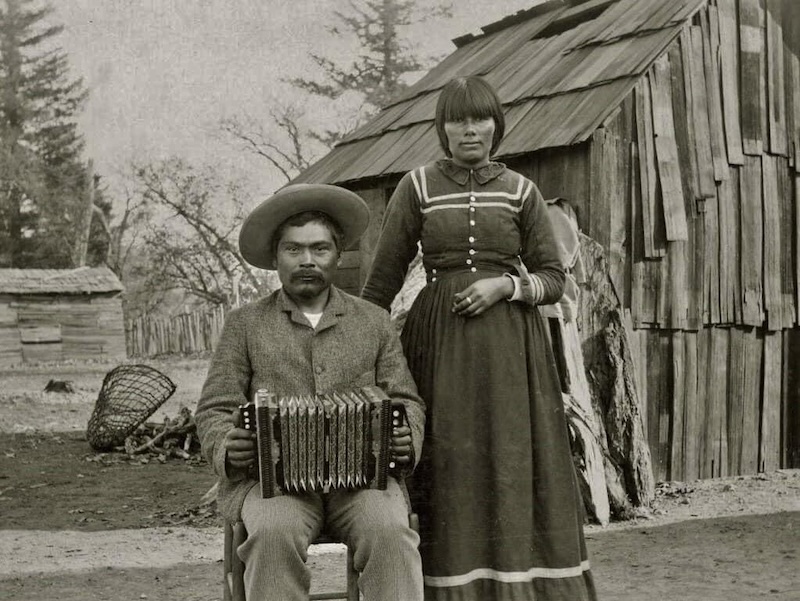November is National American Indian Heritage Month and the Kelley House Museum is observing it by opening a new exhibit on the history and culture of the Northern Pomo Indians, who have lived on the Mendocino Coast for thousands of years. The Pomo people comprised a network of Indigenous communities that crafted canoes, baskets, and other tools from local materials. Known worldwide for their exquisite baskets, they inhabited parts of Mendocino, Lake, and Sonoma Counties.

Charlie & Kate Wright at their home in Little River in the 1880s. Photo courtesy of their great granddaughter, Buffey Wright Bourassa.
The Pomo, Cahto and Yukis hunted, gathered, fished, and traded in this coastal area. The Pomos occupied the region stretching from the Noyo River in Fort Bragg to the southern part of Mendocino County. Their territory was divided into Northern, Central, Southern, and Southwestern Pomo communities. The Coast Yukis resided in the area extending from the Noyo River to the Ten Mile River and beyond to the north. The Cahtos traveled here from the area around what is now Laytonville.
Numerous shell mounds are scattered along the coastline, indicating where Indigenous communities once gathered seasonally to harvest, consume, and store shellfish and seaweed. When William Kelley and Jerome Ford arrived in Mendocino in 1852, there was a Pomo village located just east of the current Highway 1 bridge on the north side of Big River. According to Samuel Barrett, an anthropologist and linguist who studied the Indigenous people of Northern California, “They established a village they called Bu’ldam (pronounced Bool-dam), signifying the ‘big holes,’ the blowholes on the headlands at Mendocino and Russian Gulch.”
The Pomo’s way of life was significantly altered by the arrival of Russian fur trappers at Fort Ross in 1811, Spanish missionaries at San Rafael in 1817, and Euro-American settlers in the 1850s who came for the redwood forests. Logging activities replaced their villages near rivers and streams; their land was appropriated, and their lives were threatened by violence and deadly epidemics of cholera and smallpox.
Many Northern Pomo were relocated to the Mendocino Indian Reservation, established by the federal government in 1856 on 25,000 acres between the Noyo and Ten Mile Rivers. Thousands of California Indians—Northern Pomo, Southern Pomo, Yuki, Wappo, and Whilkut—were gathered from as far away as Eureka and Chico and held on the reservation for about nine years before it was closed in 1866. Most of the inhabitants were then relocated elsewhere, with many force-marched inland to the Round Valley Reservation. In 1869, the Mendocino Reservation lands were offered for sale to the non-Indian public for $1.25 an acre.
In 1903, Samuel Barrett documented three sites along the Mendocino Coast—in Fort Bragg, Noyo, and Little River—where Pomo Indians still lived, having managed to remain there when the reservation closed. The Fort Bragg site was just outside the northeastern boundary of the city, about half a mile from the ocean. There had been five houses there and maybe 20 people, but many of them moved to the Noyo site, situated on the site of a former sawmill on the northern bank of the Noyo River near its mouth. Their descendants are still there today.
Barrett was told by his Indian informants that the main trail from the Ukiah Valley to the coast, one of the earliest routes the Pomos used through the mountains, ended at the site of the Little River village. It was on a low ridge just south of the river and consisted of two houses and around six residents. There is no trace of it today.
But the Pomos are still here! Come to the museum to learn their more recent history, look at photos, and enjoy some Pomo baskets and contemporary artwork. The exhibit was made possible by an Arts and Culture grant from the Community Foundation of Mendocino County; it was curated by the Kelley House staff in consultation with Buffey Wright Bourassa, a member of the Sherwood Valley Band of Pomo Indians in Willits. The important exhibit runs through March.
The Kelley House Museum is open from 11AM to 3PM Thursday through Monday. Walking Tours of Mendocino are available throughout the week. Visit the Kelley House Event Calendar for a Walking Tour schedule.